The painting style of ancient Indian civilization has left an indelible mark, requiring a keen eye to truly appreciate and master them. From Kerala murals to Pahari artworks to Kalighat paintings, the list goes on with each style boasting features that bestow upon them a rare individuality. In this exploration let us focus on two distinctive styles of paintings originating from two different regions of India: the Kangra from the Pahari school of paintings and the Kishangarh from the Rajasthani School of paintings. Despite their regional differences, they share certain commonalities :
- Theme-Both Kishangarh and Kangra prominently feature themes revolving around the divine love and the devotion of Radha, Krishna and the gopis. Both of them beautifully depict scenes such as enchanting Ras Leela, Krishna playing the flute, and the romantic encounters between Radha and Krishna and gopis (female cowherd friends).
- Emergence- In the 18th century, a remarkable resurgence of the Bhakti movement sparked a flourishing of spirituality, art, and culture. Within this context, both Kangra and Kishangarh schools emerged amongst other schools showcasing the spirit of the age.
- Elegance and Royal touch- Both these styles are known for imparting a sense of regal touch to their paintings. The use of natural colours and their portrayal of bejewelled gods reflect the royal patronage and artistic taste.
- Medium- Kangra and Kishangarh paintings are primarily executed in the miniature painting style.
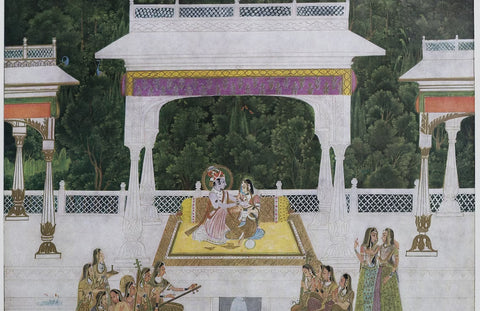
Kishangarh art - Krishna and Radha are positioned at the centre, surrounded by their female companions.
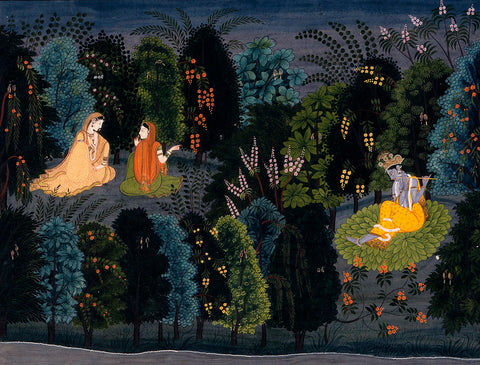
Kangra depicting Krishna and his female cohorts
While Kishangarh and Kangra share certain characteristics, they also exhibit subtle nuances that set apart their artistic expression. Let's delve into these details:

Kangra Fort in the district of Kangra.
ORIGIN: The origin of Kangra art revolves around the harmonious convergence of art forms practised by the Kashmiri painters and the styles of the Guler artists in the 18th century. Along within the picturesque sub-Himalayan report Indiarth-India. The journey of Kangra art first took shape with a coarsely flamboyant style. Scholars concur that during the early 18th century the artistic style of the Seu family and other artists aligned with the Basohli idiom. From the mid-18th century onwards, the style transformed, evolving through the pre-Kangra phase, eventually maturing into a refined Kangra style. Over time it blossomed into one of the most sophisticated styles of Pahari painting, emerging from mountainous or hilly regions. The Kangra art form reached its zenith under Maharaja Sansar Chand who established the supremacy of Kangra over surrounding hill states in his sovereignty.
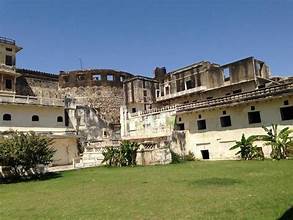
Kishangarh fort
Kishangarh paintings have long been seen as the most stylized form of Rajasthani miniature. Originating in the central state of Rajasthan, they flourished under the patronage of King Savant Singh, who ruled from 1748 to 1757. King Savant Singh was a skilful versifier, but as per Kishangarh artist Shehzad Ali Sherani, the poetries of Bani Thani (the royal court singer) were equally exceptional. It was the celebrated artist Nihal Chand who immortalised the devotion of Savant Singh and Bani Thani towards Krishna and Radha Rani through his finesse. The artworks by Nihalchand aptly emanate their reverence for the Pushtimarg cult of Vallabhacharya.
THEME: While both the schools are inspired by Hindu mythology, Kangra paintings recurrently infuse themes of tenderness, intimacy, and verdant vegetation consisting of creepers, and tree rivulets. The amorous poems composed by Jayadeva became a framework for the artists that aided them to visualise and paint the immersive romance between Radha and Krishna, the passionate love of gopis and the luxuriant wilderness.
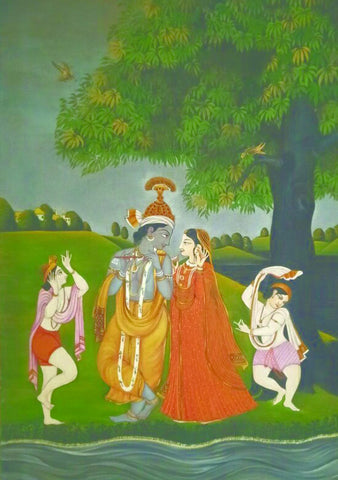
Kangra miniature painting depicting Radha and Krishna.
The central themes usually include one of the six seasons, modes of music Geet-Govinda, Nala-Damayanti, Bhagavata-Purana, and Bihari-Satsai. It would not be wrong to state that the prevalence of the Bhakti movement played a vital role in providing a solid context to the Kangra art form. Radhika is happy and proud, she is the epitome of beauty while her lover tenderly woos her.
The Natya Shastra describes the above nayika as follows:
uchite vaasake yaa tu rati sambhoga lalasaa
mandanam kurute hrishta saa vai vaasakasajjitaa (24:212)
‘The lady who embellishes herself with various jewels and adornments and eagerly waits for her beloved’s arrival with happiness is known as a vaasakasajjita nayika.’
When we talk about Kishangarh miniature paintings, the name of master artist Nihal Chand becomes synonymous with the very essence of the art form. Legend has it that King Savant Singh who composed his verses under the pen name of Nagari Das, left his throne and journeyed to Vrindavan, the birthplace of Lord Krishna, accompanied by Bani Thani, the graceful court singer and his confidant. Their profound dedication and poetries thus served as the bedrock for the portrayal of Bhakti rasa and the eternal love between Radha and Krishna in the Kishangarh paintings.
raja rasa keli sudhā piya kaiṁ
Shira vidyā-vādani nāṁhi jhagari haiṁ
nāgari dāsa vāsa vṛindāvana
nita vihāra taiṁ kabahuṁ na ṭarihaiṁ
We drink the rasa of Braja nectarean pastimes and don't waste our time in arguments about doctrines. Nagari Das lives in Vrindavan and never gives up singing of the Nitya Vihara
- King Savant Singh.
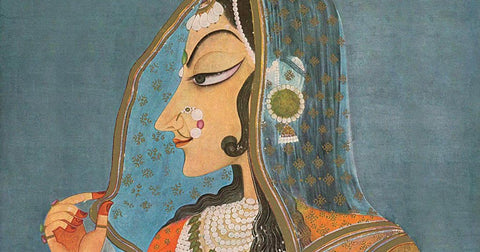
Enchanting Mystery: Is She the Royal Singer Bani Thani or Radha?

Bejewelled image of Lord Krishna and his companion
It is assumed that in these paintings, the King personified Krishna while elegant Bani Thani became the model for Radha. Indeed, the panoramic landscapes, capturing the scenic beauty of Rajasthan has been well attended by the artists of Kishangarh. It is the masterpiece creation of Nihal Singh, featuring an enigmatic lady imbued in the Shringar rasa, who is thought to represent either the King’s consort or Krishna’s beloved, that still manages to capture the attention.
STYLE:
Whether it is the Basohli school, the Guler school, or the Kangra school, the Pahari styles eloquently portray the concept of devotion and life as has been depicted in the Hindu epics. Similarly, the Rajasthani styles also conveyed these concepts with artistic finesse. The themes depicted in both Rajasthani and Pahari paintings capture the essence of Shringar (love and beauty), bhakti (devotion), as well as the splendour of courtly life. These rich artistic traditions serve as a testament to the cultural heritage and creative brilliance of India's historical past.
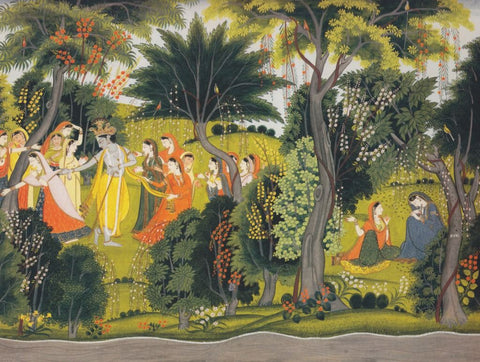
Krishna with gopis amidst bountiful vegetation
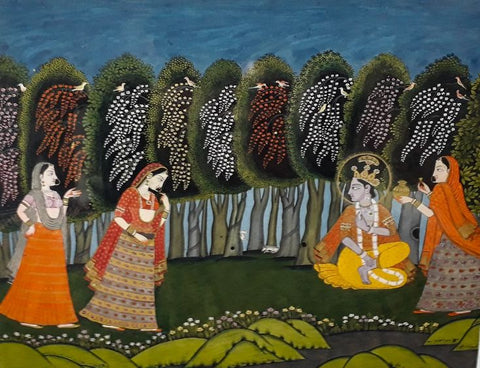
Kangra: one of the most poetic and lyrical Indian styles.
Some of the identifiable hallmarks of Kangra school encompasses the use of delicate lines, drawn with fine brushes and the incorporation of intricate decorative elements. Their countenances take on a soft and refined quality with the use of primary colours. The facial features exude a certain level of feminine charm. The artists utilise natural pigments of yellow, blue and red that enrich the radiance of their creations. Radha, the well-adorned nayika, exudes feminine grace and pride, while Krishna the nayak reciprocates the sentiments he receives from her. Moreover, animals and birds are thoughtfully included when required, giving the art a lyrical, lucid and naturalistic essence.
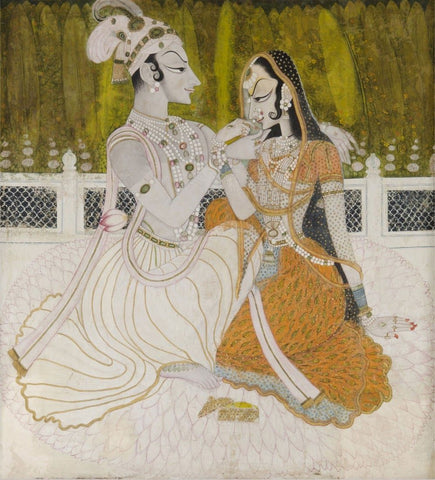
Radha and Krishna on the terrace, Indian miniature painting- Kishangarh style
The true brilliance of Kishangarh art lies in features such as the aquiline facial structures, receding foreheads, deeply curved eyes, and sinuous locks. Indeed, the infusion of the Mughal style has added a touch of sovereign splendour to the romance and religious passion. Similarly, the elongated noses and chins of central figures elevate the art to another level altogether. Here again, natural pigments derived from stones were readily employed by the royal painters. Some of the shades used include deep blue for Krishna’s complexion, shades of green are frequently employed to bring vegetation to life, and deep and metallic tones add elegance to jewellery and attire. Muted pastel tones and earthy shades of brown, and ochre are applied for architectural elements and landscapes. Meanwhile, special attention is given to jewellery, clothing and other ornamental elements.
CONCLUSION:
The princely states of Malwa, Mewar, Bundi, Bikaner, Kota, Jaipur and other regions played a pivotal role in giving rise to the Rajasthani school of paintings between the 16th and early 19th centuries. This artistic tradition encompassed a wide array of themes, including darbar scenes, garden parties, courtiers and botanical beauties, all of which were deeply influenced by the Vaishnavite cult that gained popularity in the Western region.
While the precise genesis of Pahari paintings remains uncertain. B.N Gowswamy, a prominent scholar of the Pahari school contends that Pandit Seu (Shiv) was primarily responsible for shaping the course of Pahari paintings. Be it the Basohli school, the Guler school or the Kangra school, these Pahari styles are rooted in the concept of love and life underlined in the Indian epics.
In both Kangra and Kishangarh, a common thread emerges from the adept fusion of shringar and bhakti elements within the context of court life. This common thread as well as the contrasts has substantially contributed to the rich artistic heritage.
- Das, Jagadananda. Nagari Das, January 28, 2012. http://jagadanandadas.blogspot.com/2009/03/nagari-das.html.
- Ashtanayika in the poetry of SOORDAS ... - eambalam. Accessed February 29, 2024. https://www.eambalam.com/samaagama/featuredarticles/fa_aug_2014.pdf.
- “Kishangarh Painting.” Encyclopædia Britannica. Accessed February 29, 2024. https://www.britannica.com/art/Kishangarh-painting.
- “Kishangarh Directory.” https://www.kishangarhonline.in/. Accessed February 29, 2024. https://www.kishangarhonline.in/city-guide/art-forms-in-kishangarh.
- Katekar, Rucha. “Kangra Painting - The Delicate Art of the Himachal Pradesh.” Caleidoscope, July 14, 2022. https://www.caleidoscope.in/art-culture/kangra-painting.
- “The Dominant Themes of the Kangra School of Painting.” Testbook, January 19, 2024. https://testbook.com/question-answer/the-dominant-themes-of-the-kangra-school-of-painti--5fa516ef637e785d8ff3cae8#:~:text=The%20focal%20theme%20of%20the,a%20focus%20on%20facial%20features.
- “Kangra School.” INSIGHTSIAS - Simplifying UPSC IAS Exam Preparation, September 5, 2021. https://www.insightsonindia.com/indian-heritage-culture/indian-paintings/pahari-style-of-painting/kangra-school/.
- The Pahari schools of painting. Accessed February 29, 2024. https://ncert.nic.in/textbook/pdf/lefa105.pdf.
- “Kishangarh School of Painting.” MAP Academy, December 9, 2023. https://mapacademy.io/article/kishangarh-school-of-painting/
- Rajasthani schools of painting. Accessed February 29, 2024. https://ncert.nic.in/textbook/pdf/lefa102.pdf.






















